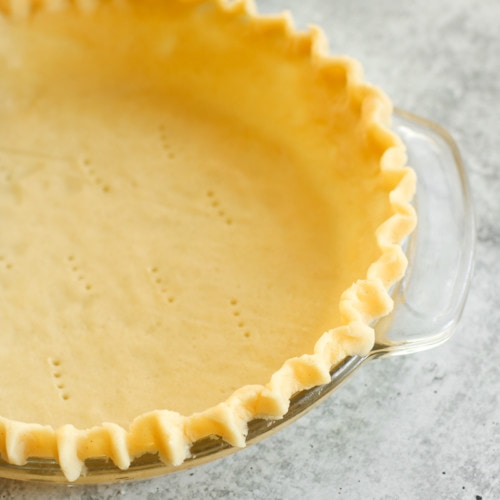Servings: 2 crusts (8-10 servings per crust) 1x
Ingredients
- 2½ cups gluten-free flour blend (we recommend using 325g of King Arthur All-Purpose Gluten-free Flour or 360 g of Bob’s Red Mill One-to-One Gluten-Free Baking Flour)
- 1 cup (2 sticks) cold, unsalted butter, cut into ½ inch thick slices (may sub plant-based stick butter)
- ½ teaspoon fine salt
- 2 tablespoons sugar
- 1 teaspoon apple cider vinegar (may substitute white vinegar)
- 1 large egg
Instructions
To make the dough balls:
- In a large bowl, combine the flour and butter.
- Using a pastry cutter, cut the butter into the flour until the dough resembles a crumbly texture about the size of small peas.
- Add the salt, sugar, vinegar, egg, and 2 tablespoons cold water. Stir to mix
- With clean hands, continue to work the dough until it comes together, forming a loose, large ball. The dough should stick together pretty easily, but if not, add 1-2 teaspoons more cold water.
- Divide the dough in half and form each portion into a ball (you’ll have two dough balls).
- Place each ball in the center of a large sheet of parchment paper.
- Fold the paper over and press down to form a thick, round disc. Wrap the disc.
- Repeat steps 6-7 with the other dough ball.
- Place the wrapped dough balls in the refrigerator to chill. If you only want to make a single-crust pie, wrap one of the dough discs tightly with plastic wrap and place in the freezer to save for a future pie.
- Chill the dough discs at least 30 minutes or up to 2 hours. If chilling longer, you will need to allow the dough to set at room temperature for 15 to 30 minutes before rolling it out.
To roll the dough out:
- Remove the dough from the parchment paper and dust the paper lightly with flour.
- Place the dough back onto the center of the parchment paper and dust the top of dough lightly with flour.
- Cover with another sheet of parchment paper.
- Using a rolling pin, roll the disc into an ⅛- to ¼-inch-thick round. If the dough starts to stick to the parchment paper, add more gluten-free flour as needed.
To transfer the first pie crust into the pie plate:
- Remove the top parchment paper.
- Mist a 9-inch pie plate with nonstick spray and place upside down over the pie crust.
- Gently slide your hand under the bottom layer of parchment paper and quickly, but gently, flip the pie plate and crust over so it is right side up.
- Carefully remove the remaining parchment paper from the dough.
- Gently press the dough into the bottom and up the sides of the pie plate.
- Use a knife to remove any excess dough that hangs over the edges of the pie plate, but leaving enough to create a thick edge.
- Add a decorative pattern to the edge of the dough, if desired, such as a fluted edge.
- The crust is ready for filling it or par-baking.
Notes
- This recipe makes enough dough for two single-crust pies or one double-crust pie.
- If making a pie that calls for a single crust, you can freeze one of the discs or form a pie crust in a pie plate wrapped or covered with plastic wrap for up to 3 months.
- You can place a dough in parchment paper, pressed down to a disc shape, and keep it in the refrigerator for up to 5 days. Allow to sit at room temperature for 30 minutes before rolling out.
Nutrition Information
- Serving Size: 1/8 of 1 pie crust
- Calories: 175
- Fat: 12 g
- (Sat Fat: 7 g)
- Sodium: 241 mg
- Carbohydrate: 16 g
- (Fiber: 2 g
- Sugar: 1 g)
- Protein: 1 g
- Cholesterol: 39 mg
